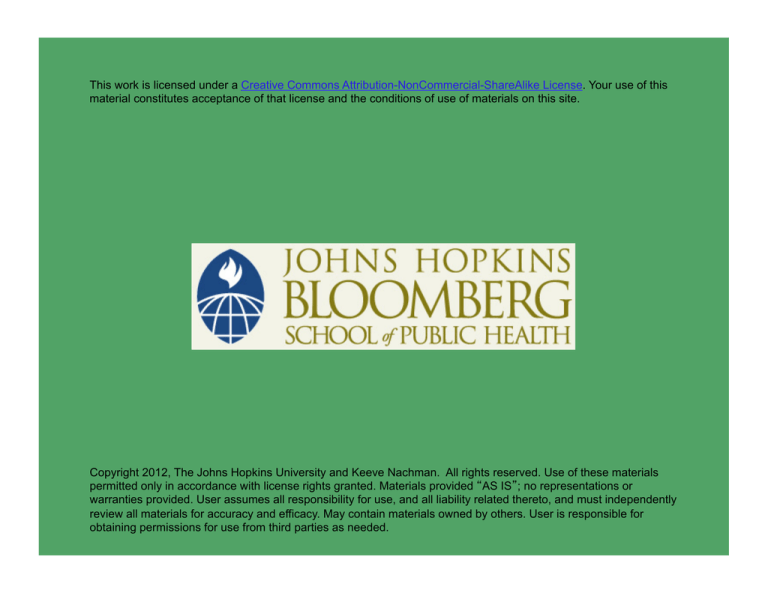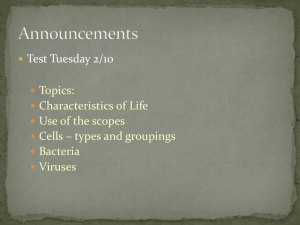
This work is licensed under a Creative Commons Attribution-NonCommercial-ShareAlike License. Your use of this
material constitutes acceptance of that license and the conditions of use of materials on this site.
Copyright 2012, The Johns Hopkins University and Keeve Nachman. All rights reserved. Use of these materials
permitted only in accordance with license rights granted. Materials provided “AS IS”; no representations or
warranties provided. User assumes all responsibility for use, and all liability related thereto, and must independently
review all materials for accuracy and efficacy. May contain materials owned by others. User is responsible for
obtaining permissions for use from third parties as needed.
Section C
Antibiotic Use in Industrial Food Animal Production
Copyright © 2012 Johns Hopkins University and Keeve Nachman. Creative Commons Attribution-NonCommercial-ShareAlike License 3.0.
Antibiotics: A Landmark Medical Advance
"Crude death rate (infectious diseases) USA, 1900-1996" from Public Health Biology. Available at: http://ocw.jhsph.edu. Copyright © Johns
Hopkins Bloomberg School of Public Health. Creative Commons BY-NC-SA. Adapted from Armstrong et al. JAMA 1999;281:6-66
3
Uses of Antibiotics and Resistance
n
Antibiotic uses
-
-
Clinical medicine
-
Other uses
Crop production
Animal agriculture
Terrestrial
Aquaculture
Ethanol production
n
All uses contribute to resistance development
- Some contribute more
n
The extent of the problem of resistance that can be blamed on
antibiotic use in IFAP is unclear
4
Antimicrobials Registered as Feed Additives in the US*
*Many of these drugs/drug classes are the same as those used in human clinical medicine
5
Usage Estimates (Millions of Pounds per Year)
AHI
(2000)
UCS
(2001)
AHI
(2008)
FDA
(2010)
Human use
32.2
4.5
Not
estimated
7.3
Animal (non-therapeutic)
3.1
27.6
27.8
28.8
Animal (therapeutic)
14.7
2
• Data availability
• Estimation methods and conflicting interests
• Divisive terminology
6
Antimicrobial Use
n
Multiple purposes (FDA)
n
Treatment
n
Control
n
Prevention
n
Production
- Growth promotion
- Feed conversion
7
Antimicrobial Use
n
Multiple purposes (FDA)
n
Treatment
n
Control
n
Prevention
n
Production
- Growth promotion
- Feed conversion
n
Eighty percent of antimicrobials in the US are sold for use in food
animal production
8
Antimicrobial Misuse
n
Prevention and growth promotion
-
-
-
-
Lower dose
Longer duration
Feed and water
Limited veterinary oversight
16%
Water
Antimicrobial Sales, by
Dosage Form, 2009
10%
Other
74%
Feed
9
Antibiotic Resistance
10
Origins and Perpetuation of Resistance
n
Primary mechanisms of development and dissemination of
resistance
-
-
-
-
n
Natural selection
Sharing of resistance genes
Mutagenesis
Reservoir of resistance
Recent findings
- Community dynamics
11
Resistance Selection
12
Horizontal Gene Transfer
n
Bacterial transformation
n
Bacterial transduction through phage virus infection
n
Bacterial conjugation
Source: Fuyura. (2006). Nature Reviews Microbiology.
13
Mutagenesis and Resistance
n
Bactericidal antibiotics
-
E.g., β-lactams, quinolones, and aminoglycosides
n
Application to aerobic bacteria at levels below those that induce
selection pressure can make bacteria produce reactive oxygen
species (ROS)
- Hydroxyl radicals
n
ROS can be DNA-reactive and produce point mutations
n
Accumulation of mutations in bacteria have been shown to induce
the development of mutant strains that demonstrate resistance to
multiple drugs
Source: Kohanski et al. (2010). Molecular Cell.
14
Reservoir of Resistance
n
The “resistome”
n
Bacteria that are not pathogenic can harbor genes that confer
resistance when shared horizontally with other bacteria
Source: Wright. (2007). Nature Reviews Microbiology.
15
Community Dynamics
n
Bacterial altruism
n
Bacteria that have mutation allowing drug resistance can share
chemical signals with drug-susceptible bacteria
n
Formally susceptible bacteria can become resistant
Source: Lee et al. (2010). Nature.
16
Dose Imprecision
n
Most antibiotics in IFAP are administered through feed or water
n
Numerous factors influence precision in dose delivery
-
-
-
-
n
Feed quality control
Behavior of animal production facility workers
Animal/herd dynamics
Drug absorption, pharmacokinetics
It is unlikely that antibiotics can be delivered at predictable or
intended doses through feed
17
Dose Imprecision May Increase Resistance Development Rate
n
Over-administration can lead to drug residues in food animal
products and clinical toxicity in animals
n
Under-administration can lead to genetic mutations that allow
resistance to emerge
n
Intermittent dosing in which variability can lead to over- and/or
under-administration that can then lead to antimicrobial selection
pressure and/or disease treatment failure
Source: Love et al. (2011). Environ Health Perspect.
18
Exposure, Risk, and
Relevant Policy
19
Pathways of Exposure to Resistant Bacteria
Source: Silbergeld et al. (2008). Medical Clinics of North America. Copyright © 2008 Elsevier Inc. All Rights Reserved.
20
Consequences of Resistant Infections
n
Health and economic burden
-
Resistant infections respond poorly to one or more antibiotics
and increase mortality risk
Estimated 19,000 deaths from HAI in 2001 (IOM, 2008)
-
Extent of burden from animal production not
estimated
-
Hospital stays are longer and more costly for resistant infections
E.g., MRSA vs. MSSA
- Hospital stay increased by 14 days (Kim, 2001)
- Average cost of a hospital stay: $45,920 vs. $9,699
(McHugh and Riley, 2004)
-
Multiple estimates of societal cost of resistant infections
IOM (1998) estimated domestic cost to be as high as $30
billion per year
21
The Danish “Experiment”
n
Denmark passed legislation to restrict use of non-therapeutic
antimicrobials in swine production
-
n
Elimination of GPA use in finishing pigs in 1998, and in weaners
in 2000
Results of the ban have since been evaluated with regard to changes
in antimicrobial use, animal production indices, and animal health
22
Results of the Danish GPA Ban
n
Indicators of animal health have revealed a beneficial effect
(weight gain, mortality)
n
Total antibiotic consumption has declined by more than 50 percent
n
Reductions in resistance in animal pathogens, indicator bacteria,
and zoonotic microorganisms
n
Precedent setting: “The United States has an effective model in
Denmark to draw upon when it comes to protecting public
health.” (NAS, 2010)
23
Relevant Domestic Policy
n
Animal Drug User Fee Act (2008)
-
n
FDA collects and releases aggregated sales data for antibiotics
in food animal production
Preservation of Antibiotics for Medical Treatment Act (PAMTA)—
introduced in current session
- Limits the use of “medically important” antibiotics in food
animal production
24
Relevant Domestic Policy
n
Strategies to Address Antimicrobial Resistance Act (STAAR)—
introduced in current session
-
Data collection and dissemination regarding antibiotics use in
humans and animals
-
Funding for interagency task force, “real-time” monitoring
25
Conclusions
n
Antibiotics are a critical tool in clinical medicine
n
The same antibiotics are used in animal agriculture for nontherapeutic purposes
n
Antibiotic use in animal agriculture promotes the emergence and
propagation of resistant bacteria
n
Many environmental pathways exist for the spread of resistant
bacteria from animal production sites to people
n
Domestic policies have been proposed to address the use of
antibiotics in IFAP
26







